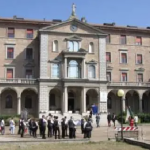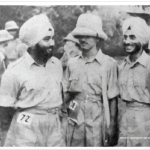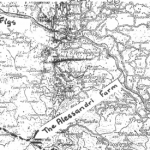Summary
test
The full story follows, in two versions. The version in the first window below is the original scanned version of the story. In the second window below is the transcribed version in plain text.
new clothing and footwear, which was British army battle dress mand boots also under clothing. All this was from Red Cross HQ at Geneva. During this 3-week period it was virtually a quarantine period.
From Brig we were taken to a large town called Wil, 25 miles northeast of the city of Zurich, which is in the German-speaking north of Switzerland and from the region of which the frontier guards had come from.
[digital page 49]
Switzerland Wil to Wald
In Wil we were again billeted in an empty school for about 10 days and we were given the same food as was being sledded up to the Swiss guards who were looking after us. At this time, we had become great curiosities for the Swiss civilians who spent quite a bit of time trying to talk to us in their unusual Swiss-German dialect ‘Switzer-Deutsch’. The main food here was: breakfast – Ersatz, imitation coffee or proper cocoa and a large bread roll. Lunch – large bowl of soup and bread rolls. Evening meal – soup, potatoes, bread and cheese. On Sunday evenings a small piece of meat also.
It was while we were at Wil that a few more escapees (‘evadés’ as we were called by the Swiss) joined our group. The ones I remember most vividly were Frank Nelligan, Pat Simmons, Cyril Pratt and Harold Daglish who married a Swiss girl who lived in the village of Wald, where we finally ended up. Her parents owned the restaurant ‘Toggenburg’ where most of the ‘evadés’ spent their weekly pay of 15 francs on ‘Möst’ (apple cider) and wine. The money was deducted from our army pay books. Beer was also available, light or dark, in German ‘helle oder dunkel’.
[digital page 50]
Switzerland Wald
In Wald all the ‘Internisten’ as we had then become known as, were billeted in a disused factory. Our beds were, as usual, loose hay on the floor but it was quite comfortable. Between the columns supporting the roof we fixed wires to hang our clothes and towels on. Plenty of blankets were supplied. Wald became quite a big camp for escapees from Italy and Germany who included Australians, English, South Africans and a few Cypriots.
An English captain was put in charge of us. His name was Mitchell. A very nice bloke and very easy to get on with. His job was to liaise between the Swiss authorities and us. We were classed as being in ‘open internment’ which meant that we could walk anywhere within a 5-kilometre radius of the Town Hall 7 days a week. The rules were that we had to be in the ‘Fabrik’ ie factory at 9pm and could not leave it before 8am the following day. It was Captain Mitchell’s duty to see that this rule was complied with and to report to the Swiss army officer after roll call. As we were all dressed in English army battle dress, we were all called ‘Engländer’ by the Swiss, which is the German name for English people.
[digital page 51]
Switzerland Wald – Montreux
It was about mid-November 1943 that we were settled into the village of Wald.
Our group of 4 got a job at the local aged persons’ home ‘Altesheim’ and the Matron in charge was a very friendly and considerate lady and made sure we got plenty of food whilst working there. She called herself our ‘Schweizermutter’ ie Swiss mother. Her husband also worked there as the general manager. Their names were Ernst and Klara Altwegg.
In March 1944 I met an English couple, Mr and Mrs Gwyn Roberts who told me that they were the owners of a college near Montreux on the Lake of Geneva. They were looking for
Italian test
[Pagina digitale 2]
[Sottotitolo] PREFAZIONE
II Centro Culturale DINOS di Amandola, associazione da anni attiva nel campo della cultura, è lieta di portare a conoscenza della cittadinanza e dell’intero territorio questo opuscolo scritto nell’ agosto del 1944 dal compianto concittadino Alessandro Terribili è riguardante i tragici eventi che seguirono I’armistizio del 1943.
La seguente ristampa dal titolo “Guerriglia partigiana in Val di Tenna”, opera ormai introvabile e ai più sconosciuta, è frutto della passione e dell’attività di ricerca che caratterizza I’associazione.
L’ opuscolo, scritto di getto dall’ autore per la commemorazione dei caduti tenutasi nel teatro comunale di Amandola il 27 agosto 1944 alla presenza delle autorità civili e militari alleate e italiane della provincia, è stato presentato lo stesso giomo nel quale veniva dedicata una lapide in memoria del martirio di Angelo Biondi.



